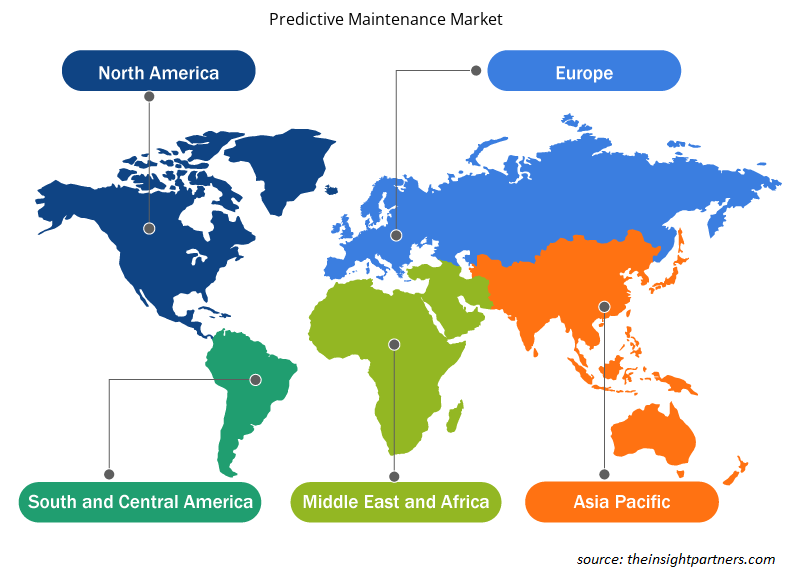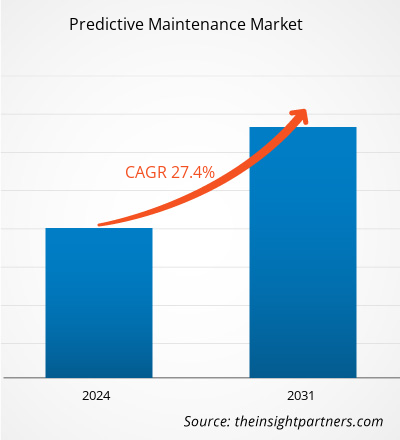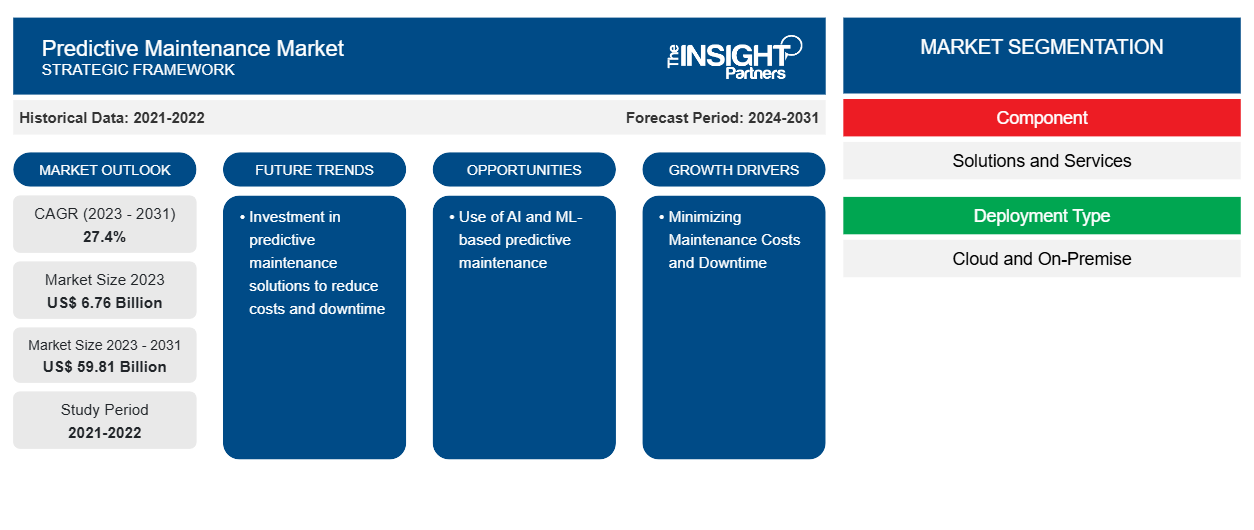Si prevede che la dimensione del mercato della manutenzione predittiva raggiungerà i 59,81 miliardi di dollari entro il 2031, rispetto ai 6,76 miliardi di dollari del 2023. Si prevede che il mercato registrerà un CAGR del 27,4% nel periodo 2023-2031. L'investimento in soluzioni di manutenzione predittiva per ridurre costi e tempi di fermo rimarrà probabilmente una tendenza chiave nel mercato.
Analisi di mercato della manutenzione predittiva
Negli ultimi decenni, l'elevata richiesta di ridurre i costi energetici sempre più elevati e di spostarsi verso un futuro sostenibile ha reso importanti gli audit energetici. Poiché la spesa energetica è una delle principali preoccupazioni per le industrie, le aziende controllano costantemente il consumo energetico e mirano in modo significativo a ridurlo al minimo.
Panoramica del mercato della manutenzione predittiva
La manutenzione predittiva migliora le prestazioni delle apparecchiature unendo sensori Internet of Things, intelligenza artificiale e scienza dei dati. Comporta l'impiego di tecnologia abilitata al cloud per monitorare e stimare i requisiti di manutenzione in base allo stato delle risorse, nonché identificare anomalie che potrebbero portare a guasti imprevisti. Di conseguenza, i produttori traggono notevoli profitti dalla previsione dei requisiti di manutenzione delle apparecchiature al fine di risparmiare sui costi e aumentare i tempi di attività. L'approccio principale utilizzato per monitorare le risorse industriali in tempo reale è il monitoraggio basato sulle condizioni. I sensori IIoT avanzati registrano dati complessi sullo stato di salute delle macchine come vibrazioni, acustica, temperatura e RPM, tra gli altri. I dati raccolti vengono quindi valutati per identificare eventuali variazioni nelle prestazioni delle risorse o problemi che sarebbero difficili da rilevare con le apparecchiature tradizionali.
Personalizza questo report in base alle tue esigenze
Riceverai la personalizzazione gratuita di qualsiasi report, comprese parti di questo report, o analisi a livello nazionale, pacchetto dati Excel, oltre a usufruire di grandi offerte e sconti per start-up e università
-
Scopri le principali tendenze di mercato in questo rapporto.Questo campione GRATUITO includerà analisi di dati che spaziano dalle tendenze di mercato alle stime e alle previsioni.
Driver e opportunità del mercato della manutenzione predittiva
Riduzione al minimo dei costi di manutenzione e dei tempi di fermo per favorire il mercato
Le organizzazioni ora affrontano un desiderio crescente di ridurre le spese di manutenzione, i guasti delle apparecchiature e i tempi di inattività. La manutenzione predittiva è un metodo eccellente per affrontare queste difficoltà. I sistemi di manutenzione predittiva utilizzano l'analisi dei dati e l'apprendimento automatico per identificare possibili difetti nelle apparecchiature prima che si verifichino, consentendo interventi di manutenzione proattivi. Prevedere in anticipo i guasti delle apparecchiature consente alle aziende di organizzare la riparazione durante i tempi di inattività pianificati, riducendo le interruzioni delle operazioni e massimizzando i tempi di attività delle apparecchiature.downtimes. Predictive maintenance is an excellent method for addressing these difficulties. Predictive maintenance systems use uptime.
Utilizzo della manutenzione predittiva basata su intelligenza artificiale e apprendimento automatico
La manutenzione predittiva basata sull'intelligenza artificiale ha un'ampia gamma di applicazioni nella produzione. Utilizza potenti algoritmi di apprendimento automatico per valutare enormi quantità di dati raccolti durante la produzione, fornendo informazioni chiave per raggiungere l'eccellenza nella produzione. Inoltre, gli algoritmi di apprendimento automatico utilizzano enormi quantità di dati storici per simulare varie situazioni e prevedere cosa andrà storto e quando. Gli algoritmi avanzati di intelligenza artificiale riconoscono il comportamento tipico dei dati di una macchina e lo utilizzano come base per rilevare e avvisare delle variazioni in tempo reale.
Analisi della segmentazione del rapporto di mercato sulla manutenzione predittiva
I segmenti chiave che hanno contribuito alla derivazione dell'analisi di mercato della manutenzione predittiva sono componenti, tipo di distribuzione, tecnica e settore.
- In base al componente, il mercato è segmentato in soluzioni e servizi. Il segmento delle soluzioni ha detenuto una quota di mercato significativa nel 2023.
- In base al tipo di distribuzione, il mercato è segmentato in cloud e on-premise. Il segmento cloud ha detenuto la quota maggiore del mercato nel 2023.
- In base alla tecnica, il mercato è segmentato in monitoraggio delle vibrazioni, test elettrici, analisi dell'olio, rilevatori di perdite a ultrasuoni, shock pulse, infrarossi e altri. Il segmento del monitoraggio delle vibrazioni ha detenuto la quota maggiore del mercato nel 2023.
- In base al settore, il mercato è segmentato in produzione, energia e servizi di pubblica utilità, aerospaziale e difesa, trasporti e logistica, petrolio e gas e altri. Il segmento manifatturiero ha detenuto la quota maggiore del mercato nel 2023.
Analisi della quota di mercato della manutenzione predittiva per area geografica
L'ambito geografico del rapporto di mercato sulla manutenzione predittiva è suddiviso principalmente in cinque regioni: Nord America, Asia Pacifico, Europa, Medio Oriente e Africa, Sud e Centro America.
Il Nord America ha dominato il mercato nel 2023. L'uso di tecnologie moderne come Machine Learning (ML), monitoraggio acustico, Intelligenza Artificiale (AI) e Internet of Things (IoT), così come l'espansione dei canali dei clienti e le crescenti preoccupazioni sulla manutenzione delle risorse e sulle spese operative, hanno tutti contribuito alla crescita. Inoltre, l'adozione di dispositivi connessi a IoT nell'elettronica di consumo e nelle applicazioni M2M, la crescente domanda di automobili connesse nel settore automobilistico e un crescente desiderio di elettronica di consumo innovativa stanno spingendo l'espansione del mercato.IoT), as well as the expansion of customer channels and growing concerns about asset maintenance and operating expenses, have all contributed to growth. Furthermore, the adoption of IoT-connected devices in consumer electronics and M2M applications, rising demand for connected automobiles in the automotive industry, and a growing desire for innovative consumer electronics are propelling market expansion.
Approfondimenti regionali sul mercato della manutenzione predittiva
Le tendenze regionali e i fattori che influenzano il mercato della manutenzione predittiva durante il periodo di previsione sono stati ampiamente spiegati dagli analisti di Insight Partners. Questa sezione discute anche i segmenti e la geografia del mercato della manutenzione predittiva in Nord America, Europa, Asia Pacifico, Medio Oriente e Africa e America meridionale e centrale.

- Ottieni i dati specifici regionali per il mercato della manutenzione predittiva
Ambito del rapporto di mercato sulla manutenzione predittiva
| Attributo del report | Dettagli |
|---|---|
| Dimensioni del mercato nel 2023 | 6,76 miliardi di dollari USA |
| Dimensioni del mercato entro il 2031 | 59,81 miliardi di dollari USA |
| CAGR globale (2023-2031) | 27,4% |
| Dati storici | 2021-2022 |
| Periodo di previsione | 2024-2031 |
| Segmenti coperti |
Per componente
|
| Regioni e Paesi coperti |
America del Nord
|
| Leader di mercato e profili aziendali chiave |
|
Densità degli attori del mercato: comprendere il suo impatto sulle dinamiche aziendali
Il mercato della manutenzione predittiva sta crescendo rapidamente, spinto dalla crescente domanda degli utenti finali dovuta a fattori quali l'evoluzione delle preferenze dei consumatori, i progressi tecnologici e una maggiore consapevolezza dei vantaggi del prodotto. Con l'aumento della domanda, le aziende stanno ampliando le loro offerte, innovando per soddisfare le esigenze dei consumatori e capitalizzando sulle tendenze emergenti, il che alimenta ulteriormente la crescita del mercato.
La densità degli operatori di mercato si riferisce alla distribuzione di aziende o società che operano in un particolare mercato o settore. Indica quanti concorrenti (operatori di mercato) sono presenti in un dato spazio di mercato in relazione alle sue dimensioni o al valore di mercato totale.
Le principali aziende che operano nel mercato della manutenzione predittiva sono:
- Società elettrica generale Hitachi, Ltd.
- Società IBM
- Società Microsoft
- PTC Inc.
- Istituto SAS, Inc.
- Schneider Electric Italia
Disclaimer : le aziende elencate sopra non sono classificate secondo un ordine particolare.

- Ottieni una panoramica dei principali attori del mercato della manutenzione predittiva
Notizie di mercato e sviluppi recenti sulla manutenzione predittiva
Il mercato della manutenzione predittiva viene valutato raccogliendo dati qualitativi e quantitativi dopo la ricerca primaria e secondaria, che include importanti pubblicazioni aziendali, dati associativi e database. Di seguito sono elencati alcuni degli sviluppi nel mercato della manutenzione predittiva:
- Accenture plc ha acquisito Nextira, un Premier Partner di Amazon Web Services (AWS) che utilizza i servizi AWS per fornire analisi predittive, innovazioni cloud-native e un'esperienza immersiva ai propri clienti. Questi servizi e soluzioni AWS consentono ad Accenture Cloud First di migliorare le proprie competenze tecniche, offrendo al contempo ai clienti funzionalità cloud su vasta scala. Nextira fornisce servizi basati su cloud che utilizzano intelligenza artificiale all'avanguardia, apprendimento automatico, competenze ingegneristiche e analisi dei dati per aiutare gli utenti a costruire, progettare, lanciare e ottimizzare ambienti di elaborazione ad alte prestazioni. (Fonte: Accenture plc, comunicato stampa, giugno 2023)
- La divisione Gas Power di GE Vernova ha annunciato di aver firmato un accordo pluriennale per un impianto da 876 megawatt (MW) ad Al Ahmadi, in Kuwait. L'accordo pluriennale include la fornitura di parti, riparazioni, servizi sul campo, manutenzione predittiva avanzata e soluzioni digitali. (Fonte: GE Vernova, comunicato stampa, dicembre 2023)
Copertura e risultati del rapporto di mercato sulla manutenzione predittiva
Il rapporto “Dimensioni e previsioni del mercato della manutenzione predittiva (2021-2031)” fornisce un’analisi dettagliata del mercato che copre le seguenti aree:
- Dimensioni e previsioni del mercato della manutenzione predittiva a livello globale, regionale e nazionale per tutti i principali segmenti di mercato coperti dall'ambito
- Tendenze del mercato della manutenzione predittiva e dinamiche di mercato come driver, restrizioni e opportunità chiave
- Analisi dettagliata delle cinque forze PEST/Porter e SWOT
- Analisi di mercato della manutenzione predittiva che copre le principali tendenze del mercato, il quadro globale e regionale, i principali attori, le normative e i recenti sviluppi del mercato
- Analisi del panorama industriale e della concorrenza che copre la concentrazione del mercato, l'analisi della mappa di calore, i principali attori e gli sviluppi recenti per il mercato dei superconduttori
- Profili aziendali dettagliati
- Analisi storica (2 anni), anno base, previsione (7 anni) con CAGR
- Analisi PEST e SWOT
- Valore/volume delle dimensioni del mercato - Globale, Regionale, Nazionale
- Industria e panorama competitivo
- Set di dati Excel
Report recenti
Testimonianze
Motivo dell'acquisto
- Processo decisionale informato
- Comprensione delle dinamiche di mercato
- Analisi competitiva
- Analisi dei clienti
- Previsioni di mercato
- Mitigazione del rischio
- Pianificazione strategica
- Giustificazione degli investimenti
- Identificazione dei mercati emergenti
- Miglioramento delle strategie di marketing
- Aumento dell'efficienza operativa
- Allineamento alle tendenze normative























 Ottieni un campione gratuito per - Mercato della manutenzione predittiva
Ottieni un campione gratuito per - Mercato della manutenzione predittiva